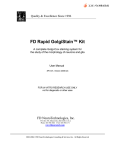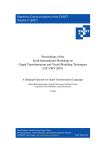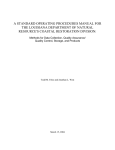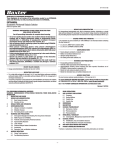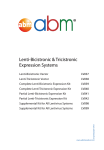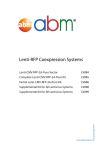Download Immortalisation Guidelines
Transcript
abm TM w w w. a b m G o o d . c o m Purified Rabbit Anti Human AATF Polyclonal antibody General Guidelines for Cell Immortalization Catalog No: Y054422 General Guidelines for Cell Immortalization Table of Contents Introduction 1 General Guidelines for Cell Immortalization 2 General Information about Viral Vectors 3 Lentiviral and Retroviral Protocol 4 • Retroviral and Lentiviral Infection of Target Cells 4 Adenoviral Protocol 5 • Amplification of Recombinant Adenovirus • Transduction of Target Cells with Adenovirus 5 6 References 6 Notes 8 Contact Information 9 • The Necessity of Cell Immortalization • Strategies for Creating Immortal Cells • Recombinant Adenoviral Vector • Recombinant Retroviral Vector • Recombinant Lentiviral Vector This product is distributed for laboratory research only. Caution: Not for clinical use. 1 1 3 3 3 General Guidelines for Cell Immortalization Introduction It has been well-documented that primary cells only undergo a pre-determined and finite number of cell divisions in culture (Stewart SA. 2002). After limited population doublings (the number of which varies by species, cell type, and culture conditions), primary cells enter a state where they can no longer divide. This state is called replicative senescence (Stewart SA. 2002, 2006). Replicative senescence is marked by distinct changes in cell morphology, gene expression, and metabolism. Morphological changes are often associated with increased cell size and the development of multiple nuclei. Activation of tumor suppressor proteins like p53, RB, and p16 are frequently seen gene expression changes. Changes in metabolism are commonly associated with increased lysosomal biogenesis as evidenced by over-expression of endogenous β-galactosidase (Ben-Porath I. 2004, 2005). The Necessity of Cell Immortalization As primary cells reach senescence after a limited number of population doublings, researchers frequently need to re-establish fresh cultures from explanted tissue -- a tedious process which can also add significant variation from one preparation to another. In order to have consistent material throughout a research project, researchers need primary cells with an extended replicative capacity, or immortalized cells. The ideal immortalized cells are cells that are not only capable of extended proliferation, but also possess similar or identical genotype and phenotype to their parental tissue. Strategies for Creating Immortal Cells Several methods exist for immortalizing mammalian cells in culture conditions. One method is to use viral genes, such as the simian virus 40 (SV40) T antigen, to induce immortalization (Jha KK, 1998, Kirchhoff C 2004). SV40 T antigen has been shown to be the simplest and most reliable agent for the immortalization of many different cell types and the mechanism of SV40 T antigen in cell immortalization is relatively well understood (Lundberg AS, 2000). Recent studies have also shown that SV40 T antigen can induce Telomerase activity in the infected cells. The most recently discovered approach to cell immortalization is through the expression of Telomerase Reverse Transcriptase protein (TERT), particularly for cells that are most affected by telomere length, such as human cells (Lundberg AS. 2005; Fridman AL, 2008). This protein is inactive in most somatic cells, but when hTERT is exogenously expressed, the cells are able to maintain sufficient telomere lengths to avoid replicative senescence. Analysis of several telomeraseimmortalized cell lines has verified that the cells immortalized by hTERT over expression maintain a stable genotype and retain critical phenotypic markers. However, over-expression of hTERT in some cell types (especially in epithelial cells) fails to induce cell immortalization and may induce cell death. Recent studies have found that co-expression of hTERT catalytic subunit with either p53 or RB siRNA can immortalize human primary ovarian epithelial cells, providing more authentic and normal cell model with well-defined genetic background (Yang G. Carcinogenesis 2007; Yang G., Oncogene 2007) . Likewise, (section continues) Page 1 of 9 General Guidelines for Cell Immortalization Strategies for Creating Immortal Cells over expression of Ras or Myc T58A mutants have also been found to be able to immortalize some primary cell types (Sears R. 2000, Weber A. 2004 ) . For the most part, viral genes achieve immortalization by inactivating the tumor suppressor genes (p53, Rb, and others) that can induce a replicative senescent state in cells (Lundberg AS, 2000). With years of experiences in cell immortalization, scientists at ABM Inc. have developed a comprehensive cell immortalization product line that is comprised of plasmids, retroviral, lentiviral and adenoviral vectors for hTERT, p53 and RB, siRNAs, and SV40 T antigens. We also offer these genes incorporated into ready-to-use recombinant retroviruses, lentivirus, and adenoviruses. All these tools will make your cell immortalization project simpler and easier than ever before. General Guidelines for Cell Immortalization Cell immortalization is a very complicated cellular process and the exact biological mechanisms are still largely not well understood. However, over the years of cell immortalization of diverse primary cells, scientists have observed: 1. Based on their in vitro culture growth patterns, there are essentially two types of primary cells: ones that can be cultured for 20-50 passages before senescence; and ones that can only be passed fewer than 10 passages before senescence. 2. Cells that have a life span of 20-50 passages under in vitro culture conditions include mostly blast cells, such as fibroblasts and retinoblasts. 3. Cells that have a life span of less than 10 passages under in vitro culture conditions are mostly epithelial cells, such as breast and ovarian epithelial cells. 4. To immortalize your primary cells, you can use either hTERT or SV40 T antigens for cells that can be cultured for over 10 passages. It is recommended that SV40 T antigens be used for difficult–to–immortalize primary cells such as epithelial cells. Also, a combination expression of Rb or p53 siRNA and hTERT can be used if a more defined genetic background of immortalized cells is required. 5. It has been shown that the introduction of hTERT may induce apoptosis in primary epithelial cells and other cells that have a life span of less than 10 passages. It is recommended to use SV40 T antigens for these cells. In many epithelial cells, epithelia growth factor (EGF) has been shown to be able to increase their life span to 10-20 passages before senescence (Ahmed 2006). Thus, one may try to add some recombinant EGF (10 ng/ml) to expand your cell life span before hTERT gene transduction. 6. For some primary cell types, it has been shown that over-expression of SV40 T antigen or hTERT alone is not sufficient for successful immortalization. However, a combinational expression of SV40 T antigen and hTERT or other genes have been shown to be effective in those cells (Matsumura 2004). 7. After gene transduction, drug selection (Puromycin etc.) is generally unnecessary for primary cells that have less than 10 population doublings as the immortalization process will select for the clones capable of growing indefinitely. Page 2 of 9 General Guidelines for Cell Immortalization General Information about Viral Vectors Primary cells are known to be resistant to transfection but receptive to recombinant viral vector transduction, especially adenoviral and lentiviral vectors. To facilitate cell immortalization, scientists at ABM Inc. have developed comprehensive, ready-to-use viral vectors for cell immortalization. The following sections outline the basic features of different viral vectors. Recombinant Adenoviral Vector Recombinant adenoviral vector is proven to be the most efficient viral vector developed to date. All types of human cells (except blood cells which lack the adenovirus receptor) can be transduced with adenoviral vectors at 100% efficiency. However, adenoviral vectors will not integrate into target cell genome, giving rise to only transient transgene expression. Vector DNA will be degraded in host cells or diluted with each subsequent cell division. Therefore, primary cells transduced with Adeno-SV40 or Adeno-hTERT are only expected to express SV40 T antigen or hTERT for 1-2 weeks, depending on the rate of cell division. Recombinant Retroviral Vector Recombinant retroviral vectors are capable of transducing actively dividing cells as retroviral vectors cannot actively transport across the nuclear membrane. During cell division, the nuclear membrane is disintegrated and thus the viral DNA can access host genome. Once the nucleus has been bypassed, retrovirus can integrate into the host genome efficiently, giving rise to permanent and stable gene expression. However, the transduction efficiency of target cells using retroviral vectors is low, especially in slowly dividing primary cells. Recombinant Lentiviral Vector Newly developed lentiviral vector can be used to transduce both dividing and non-dividing cells as lentiviral vectors can actively pass though nuclei membrane. In addition, as in the case of retroviral vectors, lentiviral vectors will integrate into a host cell genome once inside the nucleus. Thus, lentiviral vectors are gaining popularity for both in vitro and in vivo applications of gene transduction. One disadvantage associated with lentiviral vectors is the insert size. For most lentiviral vectors developed, the maximum insert size is 5.0 kb. Insert sizes less than 3.0kb can be efficiently produced at a high titer in packaging 293T cells. Viral titers will be significantly decreased by inserts longer than 3.0kb. As the SV40 genome is over 5.0kb, the expected Lenti-SV40 titer is relatively low. Page 3 of 9 General Guidelines for Cell Immortalization Lentiviral and Retroviral Protocol The following procedure outlines how to utilize retroviral and lentiviral vectors to infect target cells with cell immortalizing genes. If you are using an adenoviral vector please continue on to the following section. Retroviral and Lentiviral Infection of Target Cells 1. Thaw the recombinant retrovirus supernatant in a 37°C water bath and remove it from the bath immediately when thawed. 2. Prepare Polybrene stock to a concentration of 0.8mg/ml. 3. In the early morning, infect the target cells in a 6-well plate with 2ml/well supernatant in the presence of 2-10μg/ml Polybrene. Place the remainder of the viral supernatant in the fridge for the second infection in the afternoon. Note: Polybrene is a polycation that neutralizes charge interactions to increase binding between the pseudoviral capsid and the cellular membrane. The optimal concentration of Polybrene depends on cell type and may need to be empirically determined (usually in the range of 2–10μg/ml). Excessive exposure to Polybrene (>12 hr) can be toxic to some cells. 4. 6-8 hours later, remove the viral supernatant (from the first infection) from the wells and re-infect the cells with 2ml of fresh supernatant (with polybrene). 5. For Lentiviral vector, one infection (incubate overnight) works well for most target cells. Dilute Lentiviral vector with fresh complete medium (1:1) if cytotoxicity is a problem. 6. The next day, remove viral supernatant and add the appropriate complete growth medium to the cells and incubate at 37°C. 7. After 72 hours incubation, subculture the cells into 2x 100mm dishes and add the appropriate selection drug for stable cell-line generation. 8. For the EGFP control retrovirus, the selection marker is Puromycin. For most cell lines the selection concentration is between 1–10μg/ml. 9. 10-15 days after selection, pick clones for expansion and screen for positive ones. Note: After thawing, we recommend that the supernatant not be frozen again for future use since the virus-titer will decrease significantly. Infection of MDA-MB-468 cells would be a good control for the EGFP virus. Page 4 of 9 General Guidelines for Cell Immortalization Adenoviral Protocol The following procedure outlines how to utilize adenoviral vectors to infect target cells with cell immortalizing genes. If you are using a retroviral or lentiviral vector please see the previous section. Amplification of Recombinant Adenovirus When you place your order for adenovirus, we ship you a seed stock of adenoviral vector of 250μl. With the seed stock, you can amplify as much adenovirus as you want using the following protocol. 1. Depending on the required viral amount, you will need to grow up different volumes of 293 cells. For example, if 50ml viral supernatant is needed, five 10cm plates should be prepared. To achieve this, we recommend customers to start growing 293 cells in one well of a 6–well plate and in one 10cm dish. 2. When cells are approximately 60–70% confluent in the 6–well plate, add 100μl of primary adenovirus stock to 0.5ml of complete culture medium. Aspirate the culture medium from the 6-well plate and then add the diluted virus onto the 293 cells slowly without dislodging the cells. Return the plate to the 37°C 5% CO2 incubator for 1–2 hours before adding another 1.5ml of complete culture medium into the well. It will take 4–6 days to see over 95% of the 293 cells are detached from the well, which is called CPE (Cytopathic Effect). 3. While adenoviral vectors are being replicated in the 6–well plate, subculture the 10cm dish to five 10cm dishes. When 293 cells reach 70% confluence in 10cm dishes, add 300–400μl of crude viral stock from the previous 6–well plate directly into the 10cm culture dishes. 4. It will take another 4–5 days before the completion of CPE. Collect all cells and culture medium into a 50ml culture tube. Freeze and thaw 3 times to release the viral particles from cells. Pellet the cell debris by centrifugation at 2,000g for 10 minutes. 5. The supernatant can be used for most in vitro transduction. Store the remaining virus at 4°C if you are going to use it for transduction or the next round of amplification within a couple of weeks. Store the virus at –70°C if you are not planning to use the virus relatively soon. Note: Adenoviral vectors are more stable at 4°C or room temperature (~25°C) than lentiviral or retroviral vectors. After repeated testing, we found there is no significant loss of titer when stored at 4°C or room temperature for up to 72 hours. Virus will still be viable after one year of storage at 4°C, but long–term storage at –70°C is needed to minimize the stock titer loss. In addition, the sample should be prepared with 5% glycerol for long–term storage at –70°C. Page 5 of 9 General Guidelines for Cell Immortalization Transduction of Target Cells with Adenovirus Target cells can be transduced by recombinant adenoviral vectors by either viral supernatant or purified adenovirus. For most in vitro application, target cells can be transduced at 100% efficiency with viral supernatant from packaging 293 cells. However, purified high titer of adenoviral preparation are necessary needs to be used for in vivo applications, which requires adenoviral preparations free of FBS or other contaminants. Please refer to our Adeno-N-Pure products for detailed information on large-scale adenoviral vector purification (Cat. No. A019) 1. Prepare target cells in a 6-well plate or 10cm dish at 70% confluency at the time of transduction. 2. Aspirate the culture medium and overlay with viral culture supernatant (1ml for 6 well plate and 4–5ml for 10cm dishes) to cover the cells for one hour in an incubator. 3. Remove the medium containing the virus and replace it with fresh complete medium. 4. Gene transduction can be evaluated 48-72 hours after transduction by different assays, such as Western blot, qPCR analysis, or microscope observation if there is a color generating reporter gene. References Ahmed N, Maines-Bandiera S, Quinn MA, Unger WG, Dedhar S, Auersperg N. Molecular pathways regulating EGF-induced epithelio-mesenchymal transition in human ovarian surface epithelium. Am J Physiol Cell Physiol. 2006 Jun;290(6): C1532-42. Epub 2006 Jan 4. Ben-Porath I, Weinberg RA. The signals and pathways activating cellular senescence. Int J Biochem Cell Biol. 2005 May;37(5):961-76. Epub 2004 Dec 30. Ben-Porath I, Weinberg RA. When cells get stressed: an integrative view of cellular senescence. J Clin Invest. 2004 Jan;113(1):8-13. Review. Dimri G, Band H, Band V. Mammary epithelial cell transformation: insights from cell culture and mouse models. Breast Cancer Res. 2005;7(4):171-9. Epub 2005 Jun 3. Review. Fridman AL, Tainsky MA. Critical pathways in cellular senescence and immortalization revealed by gene expression profiling. Oncogene. 2008 Aug 18. Jha KK, Banga S, Palejwala V, Ozer HL. SV40-Mediated immortalization. Exp Cell Res. 1998 Nov 25;245(1):1-7. Review. Kirchhoff C, Araki Y, Huhtaniemi I, Matusik RJ, Osterhoff C, Poutanen M, Samalecos A, Sipilä P, Suzuki K, Orgebin-Crist MC. Immortalization by large T-antigen of the adult epididymal duct epithelium. Mol Cell Endocrinol. 2004 Mar 15;216(1-2):83-94. Review. Page 6 of 9 General Guidelines for Cell Immortalization References Lundberg AS, Hahn WC, Gupta P, Weinberg RA. Genes involved in senescence and immortalization. Curr Opin Cell Biol. 2000 Dec;12(6):705-9. Review. Matsumura T, Takesue M, Westerman KA, Okitsu T, Sakaguchi M, Fukazawa T, Totsugawa T, Noguchi H, Yamamoto S, Stolz DB, Tanaka N, Leboulch P, Kobayashi N. Establishment of an immortalized human-liver endothelial cell line with SV40T and hTERT. Transplantation. 2004 May 15;77(9):1357-65. Rosalie Sears, Faison Nuckolls, Eric Haura, Yoichi Taya, Katsuyuki Tamai, and Joseph R. Nevins. Multiple Ras-dependent phosphorylation pathways regulate Myc protein stability. Genes & Dev. 2000 14: 2501-2514 Stewart SA, Weinberg RA. Senescence: does it all happen at the ends? Oncogene. 2002 Jan 21;21(4):627-30. Review. Stewart SA, Weinberg RA. Telomeres: cancer to human aging. Annu Rev Cell Dev Biol. 2006;22:531-57. Review. Thibodeaux CA, Liu X, Disbrow GL, Zhang Y, Rone JD, Haddad BR, Schlegel R. Immortalization and transformation of human mammary epithelial cells by a tumor-derived Myc mutant. Breast Cancer Res Treat. 2008 Jul 20. Weber A. Immortalization of hepatic progenitor cells. Pathol Biol (Paris). 2004 Mar;52(2):93-6. Review. Yang G, Rosen DG, Colacino JA, Mercado-Uribe I, Liu J. Disruption of the retinoblastoma pathway by small interfering RNA and ectopic expression of the catalytic subunit of telomerase lead to immortalization of human ovarian surface epithelial cells. Oncogene. 2007 Mar 1;26(10):1492-8. Epub 2006 Sep 4. Yang G, Rosen DG, Mercado-Uribe I, Colacino JA, Mills GB, Bast RC Jr, Zhou C, Liu J.Knockdown of p53 combined with expression of the catalytic subunit of telomerase is sufficient to immortalize primary human ovarian surface epithelial cells. Carcinogenesis. 2007 Jan;28(1):174-82. Epub 2006 Jul 8. Page 7 of 9 General Guidelines for Cell Immortalization Notes Page 8 of 9 General Guidelines for Cell Immortalization Contact Information Applied Biological Materials Inc. Suite #8-13520 Crestwood Place Richmond,BC.Canada V6V 2G2 Telephone: 604-247-2416 Toll Free: 1-866-757-2414 Fax: 604-247-2414 General Information: [email protected] Order Products: [email protected] Technical Support: [email protected] siRNA: [email protected] Business Development: [email protected] Distributors North America Canada Applied Biological Materials Inc. Suite #8-13520 Crestwood Place Richmond, BC. Canada V6V 2G2 Tel: 604-247-2416; 1-866-757-2414 Fax: 604-247-2484 www.abmGood.com USA Applied Biological Materials Inc. Suite #8-13520 Crestwood Place Richmond, BC. Canada V6V 2G2 Tel: 604-247-2416; 1-866-757-2414 Fax: 604-247-2484 www.abmGood.com Mexico Sucursal México Alvaro Obregón No. 85-A Col. Roma Del. Cuauhtemoc México, D.F. C.P. 06700 Tel: (55) 55-11-77-11 Fax: (55) 55-11-88-11 www.lavoisier.com.mx Taiwan Interlab Co. Ltd. 4th Floor, No. 149-17, Section 2 Kee Lung Road, Taipei Taiwan 110, ROC Tel: +886-2-2736-7100 Fax: +886-2-2735-9807 Email: [email protected] South Korea CMI Biotech #302, 221-6, Guui-dong Gwangjin-gu, Seoul Tel: 02 444 7101 Fax: 02 444 7201 www.cmibio.com Belgium Gentaur Av. de l' Armée 68 B-1040 Brussels Tel: 32 2 732 5688 Fax: 32 2 732 4414 www.gentaur.com France Gentaur 9, rue Lagrange 75005 Paris Tel: 01 43 25 01 50 Fax: 01 43 25 01 60 www.gentaur.com Asia Japan Cosmo Bio Co. Ltd. 2-2-20 Toyo Koto-Ku Tokyo, 135-0016 Tel: 03-5632-9610/9620 Fax: 03-5632-9619 Email: [email protected] India H.D. Biosciences Pvt. Ltd. C20/A, Pandav Nagar Delhi- 110092 India Tel: +91-1122442674 Fax: +91-1122442675 Europe United Kingdom NBS Biologicals Ltd. 14 Tower Square Huntingdon, Cambs PE29 7DT England www.nbsbio.co.uk Page 9 of 9











